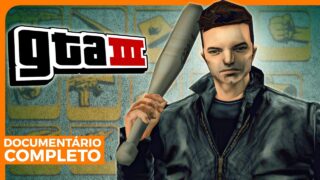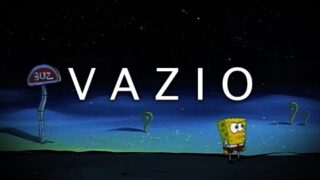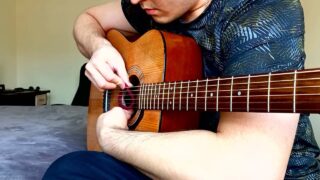Inside the Most Prepared Country on Earth
0(gunshots firing) (tense music) – I’m on my way to an
army camp in the snow, here at the top of the world, where NATO troops are
training in Arctic warfare right here next to this long,
snowy border with Russia. It’s over 1,000 kilometers long. And it separates Finland
from its neighbor, a country with 26 times
the population of Finland. Finland also borders the Baltic Sea where NATO has been clashing on the water with Russia’s shadow fleet of ships. It’s also squarely in the Arctic region, another newly vital geopolitical domain. This is a place where
empires have clashed, and where they might clash again. (tense music) Here’s the gate to Russia,
and it is totally closed. Let’s see if I can get in. I’m in Finland to train with their army as they show their new NATO allies how to fight in the high north. I’m here to sleep in the snow, to witness and participate in the rigor of Arctic warfare. But I’m also here to
go beyond the military to get a closer look
at this unique country, to understand how their past haunts them, and how these memories
have caused this quiet and peaceful people to
be constantly preparing for crisis and war, a vigilance
and awareness of threat, that might actually explain
why they’re considered the happiest people on Earth,
now, eight years in a row. From the border with Russia, to the many bunkers scattered
throughout the country, you’re about to see a pretty
unique security situation. A strategy, and a mindset borne out of Finland’s unique geography. (tense music) So I’m headed to a military base in the frozen north of the country to join over 1,000 troops in a live combat exercise in the snow. This will be the beginning of my quest to understand how this
country is preparing, and what they’re preparing for. (upbeat music) – [Interviewee] Of course, there is cold, and then there is Arctic. You have to be sure that the trooper is able to survive in these circumstances. (tense music) (gentle music) – Good. I’m Felix.
– Hey, Felix, Johnny? – Yes, nice to meet you. This is Felix. He’s a captain in the Finnish Army who is a skilled outdoorsman. He has a Master’s degree
in Arctic warfare. – And I know you like maps. – (chuckles) Yes, I do.
Oh, wow, what a treat! Military maps. Wow, this is awesome. (gentle music) Felix will soon be dropping me off in the middle of the snowy forest to fight and sleep with
the troops in the snow. But first, there’s a few important steps. First up, clothing. Here in Northern Finland, the temperatures can get
below negative 40 Celsius. The cold can be as deadly
as any artillery cannon, if not more. So this huge warehouse is
dedicated to proper clothing. (upbeat music)
(speaking foreign language) – You have to sign this. – Large or medium? – [Johnny] Oh, I think
medium, probably medium. 44? Yeah. This is all right here… This is like body armor, pad, rucksack. Everything in this big orange bag is soon gonna be on my
body, one way or another. 30 or 40 pounds. Time to get dressed. And even though I thought I
knew how to put on clothes, I quickly get schooled
on how this all works. Does this go first? – [Helper] No. The mesh shirt. – Okay, cool. – [Helper] So it’s all
about layers, basically. Did you get socks?
– I did, yeah. – [Helper 1] Yeah.
– [Helper 2] Yeah. – [Helper 1] Yup. – On this, and then.
– Ah, yeah okay. – Yeah. – First this.
– First, and then this. – [Helper 1] Yes, yeah. – So the whole concept of this is like having layers on you. Don’t put the snow camo now.
– No, not them! – Next layer, on top of those. (clothes shuffling)
(zippers squeaking) – Wow, that’s a lot of gear. Go see what it’s like
to be an arctic warrior. (soldiers faintly marching)
(gentle music) Next we wander through the base headed towards the mess hall. We grab lunch, which for
me is just an opportunity to ask nonstop questions to Felix who wrote his master’s thesis on the future of arctic warfare. And while he said he
can’t share it with me because it’s classified, I’m still peppering him with loads of questions about what arctic warfare is. Wandering throughout the base, I also get to catch up
with the military leaders who direct this group of a
few thousand Arctic soldiers called the “Jaeger Brigade.” – The Jaeger Brigade is
the northernmost unit, what the Finnish defense forces has. – As a Deputy commander of Jaeger Brigade, I, of course I have the feeling
that we are Finnish army, the most skilled unit in these conditions. – [Johnny] Next, it’s briefing time. We head to the command center to get a rundown on what’s going on here. This is Arctic Forge. It’s a large scale military
exercise in the high North. It’s a collaboration between
the militaries of the US, Canada, Norway, Sweden, and Finland. It will include over a thousand troops, all behaving as if they’re in
a real world combat scenario. Over at a nearby airfield, the US Army’s 11th Airborne Division has just landed, coming in from Alaska. They too are treating this like a real world combat scenario, behaving as if they’re quickly coming to the aid of Finland,
who’s just been attacked. – It is the situation
where Finland is a trouble. Finland is in war. We need help. And now we are piping
together, defending Finland. – [Johnny] American
troops will work together with Canadian and Finnish troops to learn how they fight
here in the Arctic. Something the Finnish army is expert at. The exercise will play out over this 40-square kilometer
swath of snowy forest. The blue team will be
comprised of Finnish troops with their new NATO allies
from America and Canada, and they’ll be trying to
defend their territory. And on the other side is the red team, that will be made up of a
few hundred Finnish soldiers acting as the invaders. They’ll be attacking,
trying to take territory. This is the team that I will be on, and I didn’t know this before I came, but they really pulled out all the stops to ensure that this is as accurate to real warfare as possible. The blanks in these guns are wood-tipped to mimic the sound and
kickback of a real bullet. And in addition to these ground forces that I’m embedding with, there’s also units of tanks
deployed in these woods, hiding in the brush and
preparing an offensive maneuver. There’s artillery cannons standing ready to fire simulated ammunition
across the front line. There’s surveillance drones in the air with thermal cameras trying
to detect our position, and real fighter jets ready
to drop simulated bombs if they see a target. – We are sending the message
that we are defending Finland and the eastern border of of NATO, and now we have also
the allies troops here to be part of that. – This multi-day exercise
is about to begin, but first, Felix wants to
put me through some training. (footsteps crunching)
(flames roaring) The conscripts here run through
physically intense training, like this exercise where they
run through a raging fire with all their gear and a gas mask on to simulate facing napalm
or other incendiary weapons. They practice shooting, shooting on skis, but perhaps most importantly, they prepare to face
the real killer up here. – There’s cold, and then there’s arctic. – Fighting in the Arctic means potentially falling into a river or one of Finland’s, nearly 200,000 lakes. So I’m about to get on some skis and fall into this river on purpose and then try to get myself out, all without panicking. So they have to make sure I’m
calm before I dig myself out. Man, what have I got myself into here? (water splashing) – [Trainer] Good job. What’s your name? What’s your name? – Johnny Harris. – [Trainer] Stay down, stay
down. What’s your name? – Johnny Harris. – [Trainer] What’s your job? – I’m a video journalist. – [Trainer] How do you like Finland? – I love Finland. – [Trainer] Is it cold down there? – It is very cold down here. – [Trainer] Okay, you may get up. – Woo! (upbeat music) All right, we’re doing
sprints now to warm up. That’s the technique. Okay, we’re warmed up. I’m half cold, half warm, but also kind of like
feeling some endorphins after that cold water. That was freaking awesome. Wow! I’m dressed and slightly warmed up. Now I’m gonna go learn how to make a fire. (wood hammering) Felix shows me the ways and makes it look pretty
easy, but now it’s my turn. (wood hammering) – You can cut this part out. – Let’s see if I can get a single light. Nope. Man, you made it look so easy! – (laughs) You’re holding wrongly. – I am not going to survive the night. Oh, this is hard! I’m
determined to make this happen. Okay, the moment of truth here. – Take the rod up a
little bit, yep, yep, yep! You got it! – Okay, there we go.
– More stuff, more stuff. More birch bark, more birch bark. – Yeah, there she is! – Oh, we got a fire folks! It seems like a lot of
these survival skills is about not panicking. Keeping yourself calm even when you kind of wanna freak out. – For US army in the tents,
they mostly use gasoline, diesel heaters, propane or whatever. And in Finland, all of our tents are basically heated up with firewood. With stoves. – I keep having to remind myself that there’s 5 million
people in this country, like that’s the size of
like the state of Oregon. And yet you guys have
this military that like, people come to learn from. It’s pretty impressive.
Do you feel proud of that? – Of course. We don’t have the budget to be like a full scale, huge army. We have the conscript service. Thank God we have stick to that. Most of the men have been
through conscript service, have a wartime duty, know how to use guns, know how to ski, like the
whole thing is embedded in the Finnish society. That if the bell rings,
we are gonna take up arms and do our job to keep
the Finland independent. (gentle music) (machine whirring) – The combat exercise has started. Felix has dropped me off
with one of the soldiers who’s taking me towards the front line. We’re now deep in the forest. I arrive to this readiness
unit of this Arctic platoon, and they’re getting ready to deploy, to mount their offensive, to try to take this nearby hill by force. NATO troops will be trying to defend it. These guys are the tip of the
spear for the Finnish army, and we’re about to see how they work. We’re getting ready to
go to the front line and do this offensive. Every weapon is actually linked to a system that calculates
the damage that it would do and where it would hit. The planners of the exercise can assess how each team is doing. They can see where
artillery fire is going, who’s shooting who, how many casualties. (gentle music) We’re plowing through this forest. In a BV, it’s a carrier vehicle that brings troops through the forest without the need of roads. They seem to be able to
move through anything. Okay, we’re on the front line here, right where we believe
the enemy position is, and we’re gonna get our skis on and start moving into the
enemy’s territory to attack. – The red force, which is mainly, or almost all are Finnish conscripts. They are starting to advance to attack. They are not typical conscripts. They are our best conscripts. And they know that on the opposite side, there is US professional soldiers. They are eager to show to US soldiers, what they can do and eager to win. – All the guys start to get
ready to do this maneuver. The drone is about to
take off the snowmobiles. There’s the comms guy with
this big radio over here. We’re mobilizing here.
This is arctic warfare. (tense music) (object shuffling) So we’re moving through
this forest right now, clearing this area. We’re on the front line
so we may encounter someone from the other side if these guys are ready. Making this offensive happen, waiting, moving into this enemy territory. (objects shuffling) (guns faintly firing) Shots ring out from a firefight that is happening from another
unit on the front line. (speaking faintly) (radio chattering faintly) (speaking in foreign language) – As you can hear, further-most squad around the objective area
is currently in a gunfight. Just, just hang back- – [Johnny] Okay. – And let them do their thing. – Okay. (soldiers talking in foreign language) (guns faintly firing) We’re close to our target. And then a few meters later… (noise ringing) (guns firing) Okay, there’s a firefight
going on up here. We’re gonna go give them some backup. (guns continue firing) (snow shuffling) My unit wins this firefight
within 20 minutes. We’ve captured these troops. It’s a unit mostly made up
of American army troops. – Guys, we’ll check your gear and see if you have anything. Anything we might have interest in. – [Johnny] These American
troops came here to train with the Arctic war experts and are finding all kinds of surprises. The first of which is just how to move through such deep snow. – He was like, sinking about this deep. I’m like, all right, I’ll be okay. And I go about this
deep, and I’m like damn! – [Johnny] And even though
they’re technically supposed to be enemies on the battlefield, the soldiers can’t help
but start talking shop. – I had sevens a little smaller. But yeah, you get thermal, you get day, you get zoom, you get lazing grids. Pretty good stuff. Earlier when I was back on the base, I caught up with another
group of US soldiers in the cafeteria. – The Finns are masters of skiing, so they’re able to basically use this terrain to their advantage. – The field craft of it is the most interesting part of it. That’s one thing you can really
learn a lot from the Finns, because there’s like the
United States Army way of doing things, technology and this, but like in environments
like this, what’s old is new. This stuff works. So being able to learn
those lessons is critical. – So through this sneaky offensive, we captured this hill, completing our objective for the morning. All of this is being updated
on a live map back at HQ. The day continues with more operations and fighting all over this battlefield. (guns firing)
(machines whirring) But we’re in the high north. The days are short here, and
soon the sun is going down. So I get to sleep out in the snow tonight, a little candy bar for the cold night. – These are the worst
conditions to sleep in. Maybe the worst possible
weather to sleep in the snow that he’s gonna be doing. – Out here in the Finish Forest. And I wouldn’t be able
to do this kind of video Night has fallen and I’m riding back to
camp on a snowmobile. We have our headlights turned off and we’re navigating with night vision. There are drones and jets in the air. They’ll be able to see us if we create too much light or heat. We’re still in combat mode. And because we’re already
so deep in this forest, we’re gonna camp out here. Here in the tense darkness, I get briefed by our unit leader. – [Leader] The situation is as follows: so we have our basic defensive posture. Squads are scattered around
there in the wilderness. Right now we are making preparations to move into the cold base – [Johnny] Cold base, that
doesn’t sound very comfortable. I learned that this means we
need to sleep in the snow, to make our shelters as cold as possible to avoid being detected by
the infrared heat sensors from the drones overhead. – The company commander’s intent is to divert the enemy
recon with this move. So we will leave our hot tents, move further into the woods. – The problem is, I have no idea how to build the ice shelter that I’m supposed to sleep in tonight. I’m told that step one
is to put on my skis and start packing the snow down. – [Leader] I really have to
go to the company command post to get my orders, so I will
see you in a couple of hours. – [Johnny] Okay, perfect.
Thank you so much. I appreciate your help. At this point, despite the
instructions I’ve been given, I still feel out of my depth. Luckily, another conscript
wanders over to help. Hello?
– [Soldier] Hi. We haven’t met yet. – [Johnny] Hi, I’m
Johnny. Nice to meet you. How you doing today? – Very nice. – [Johnny] After about 45
minutes of stomping on this snow, we start cutting the
packed snow into cubes. These will be like bricks we use to build the walls of my shelter. While we’re building, we get
talking about what it’s like to be in this unit that is
the first to go into conflict. – How do you feel about that? Does that kind of make you nervous or… – No, it’s just our job to do. – Yeah. – Protect our country, yeah. – [Johnny] All right we’ve got ourselves a nice-looking shelter here. It’s coming together slowly. – Can I offer you a piece
of Finnish chocolate? – Oh, of course! Thank you so much, wow. That’ll warm me up. Oh wow, it’s so good. – Best chocolate in the world. – It really seems like it, wow. Cool. I’ve got a place to sleep. Okay, the snow shelter is finished. Who knew I could make a snow shelter. There it is, this is my shelter. Okay. A little update. It’s now after midnight, and
the platoon leader has woken me to tell me that my shelter
does not disguise well enough. ‘Cause the tarp kind of sticks out, and my thermal signature will be picked up by infrared drones. So we have been up cutting
down trees with big branches and putting them on my roof, and then putting the tarp over that so that it’s more supportive so
I can pile it full of snow and then branches on top of that snow. So I’ve done that for the last hour, and now my shelter is very well
disguised from both optical and infrared sensors,
and I can go back to bed. The problem is, my shelter
now looks like this. All the trees that I had to put on it are now poking down into the shelter, and I’m gonna have to sleep among them. As I close my eyes, just out
of reach of the pine needles. This is where I’m sleeping,
here in my ice tree cave. See you tomorrow. I’m exhausted. And as I fall asleep, I get the feeling that I’m glimpsing
something important and old. Not just a military exercise, but an old tradition, a mindset that you can
really only understand if you know Finland’s unique story. (gentle music)
(pictures clicking) Finland is stuck between east and west. They were ruled for centuries by Sweden. Then there were conquered and annexed by the Russian Empire in the early 1800s. During that time, Russia tried
to stamp out Finnish culture, tried to turn this land and its people more and more Russian. But they resisted. And then in the early 1900s, Russia descended into a chaotic revolution that throughout the monarchy, and eventually gave rise to the first-ever large scale communist system. This would become the Soviet Union, the largest country on earth,
spanning eleven time zones. And right here, little
Finland took advantage of the chaotic revolution next
door, and they broke free. They declared independence. It got ugly for a few years,
there was a bitter civil war, but eventually, Finland emerged as a whole independent country. But the threat didn’t go away. The Soviet Union wanted to take back land that they believed belonged to them, but soon they’d find
themselves in competition with another growing empire. At first, Stalin and Hitler wanted to avoid war with each other, so they signed a pact promising
not to fight one another. But then they secretly agreed to give each other spheres of influence into which the other wouldn’t invade. On the list of countries
that were fair game for Stalin and his
Soviet Union was Finland. So just as the winter of 1939
was descending onto Europe, hundreds of thousands of Soviet troops flooded across this long
border into Finland. They had tanks and air power, and they were fighting
against a much smaller and weaker Finnish army. But despite this, the Finns fought back, Their knowledge of this terrain and their ability to
blend into these forests, to slip through them on skis and quietly camp out here in
negative 40 degree weather. Their attitude of resilience, their commitment to defending their land, all of this allowed them
to punch above their weight in what is now known as the Winter War. And they lost territory in this war, but not as much as they should have. They were able to maintain their country and their independence. Soon, World War II would
engulf this whole continent into war, genocide and conquest. That spheres of influence agreement between the Soviets and Germany was broken When Germany started conquering East, this is when Finland
saw a chance to win back some of their strategic
land that they had lost. And they made a difficult choice; accepting troops and
supplies from the Nazi regime and going on the offensive
against the Soviet Union to get their land back. It was a strategic move in a brutal war, but one that put Finland
in a compromising position of aligning with a genocidal regime. With the help of the Nazis, Finland got their land back, and then some, but eventually, the Soviets and their Western allies
started winning the war, beating back the Nazis. The Soviets then turned their attention back onto the Finns and
pushed them back to here. The Soviets made Finland pay them back, made them accept
responsibility for the war, and acknowledge that Finland
had allied with the Nazis. They were also required to remove German troops from Finland, which they eventually did, though they had to use force to do this in a short conflict in Lapland. By 1945, the devastating
World War was over, and Finland somehow remained intact, having paid a heavy price. And coming out of all of this with some serious lessons learned, a traumatic memory
imprinted on this nation. (bright music) In our conversation, we’ve
heard a lot of people bring up those conflicts, that history seems to be more present here than I normally see. – It’s still very vivid,
the war history in Finland. – After the Second World War, there’s been at least one or
two generations before me. But still, I mean, I do feel this memory because also I, well,
I know my grandparents were in the war, and
those memories just stick. – We have the winter war
and the war after that. And, well, it’s hard to forget, although I was not born here yet, but my parents were
participating in the war, so. – Our history as a small country, also our experiences from
the Second World War, I, you know, they’re a generation away. So it’s like we all have, all our families have
stories from that time. – The memory about the Winter War and continuous war, it’s there. We lost 10% of our soil
after the Winter War. I think that nobody wants to
be in that position anymore. – It has left us with some sort of wounds, like internal wounds that
might play into this, how we feel about Russia. – But this memory isn’t just
about how they lost land. It’s also about how they were somehow able to resist being conquered, especially in the Winter War, when they were fighting entirely alone against a much more powerful military. – We were able to maintain
the independence throughout. Ever since we have had to live together with this big neighbor,
not in the shadow of it, but under the breadth of Russia. And it has created a
kind of a special mindset of always being prepared. – What happened in the Second World War? It’s a really big impact
on the culture in Finland, I think still, even though
people would probably say that, nah, nah, it’s not that big of a deal. But I think it’s like this, like a very, very big
influence still today, – [Johnny] Knowing this
history made spending time with these soldiers much more meaningful. Almost all of these
soldiers are conscripts, mostly young men who are required
to serve for up to a year. Finland being one of the
few countries in Europe that still requires their
people to serve in the military. This provides yet another layer of collective memory and shared experience that makes its way into every
Finnish household and family. – [Interviewee] People of
Finland, we are not afraid. We are concerned. We know what’s in the east.
We have never forgotten that. – (sighs) What a night. It’s time to go. I have to break this fort down. I slept as well as you
would expect in a nice cave that I made here in the Arctic Circle. A lot faster to kill it than to create it. But that’s how it goes, I guess. – The platoon leader told
me that pine needle makes for some good tea. Gotta try it out. I don’t have any coffee. Pine needle tea, let’s do this. Oh, that’s nice. (tense music)
(machines whirring) We are headed towards another front line when the BV gets stuck. So the platoon is here
in this wide open area, fully exposed to the sky. We spend an hour trying to get out, but we get interrupted with the news that a recon drone has
spotted our location. And soon an F18 hornet
is speeding our way, and within seconds it
drops a simulated payload that hit right on target. The target being us, killing
nearly everyone in our unit. The surviving team
continues the simulation, acting as they would in
a real world scenario. They take stock of the wounded, they carry them out to safety. And as all of this is happening, the platoon leader breaks the
news that he was hit as well. – [Leader] I’m dead as well.
– [Johnny] Oh you’re dead too. – [Leader] There won’t be any advantages, this platoon is not doing anything. – It’s game over for my unit. We had a good run, and I’m certainly much more informed on what arctic warfare actually means. My time at the base is over. My next stop is the Russian border. But before I say goodbye to the troops, Felix insists that we end our adventure in a traditionally Finnish way; a sauna Saunas are a big part of the culture here, and military is no exception. This is a real sauna,
heated by those embers. (pipes squeaking)
(attendees chattering) And even though my training is done, I can’t help but head down to an ice hole cut into the river. – [Onlooker] He’s done this before. – I’m alive. I got it. Woo! That was amazing. Oh man,
there’s nothing better! (onlookers chuckling)
There is nothing better. – [Onlooker] That’s crazy! (group laughing) – Okay, now it’s time to head east towards that blood soaked
border with Russia. To continue my journey, to understand the
Finnish security mindset, it’s becoming clear that the
military is just one layer. The rest of the story
takes place elsewhere in underground bunkers,
hiding beneath cities, and along this line in the woods, whose violent history is
still on everyone’s minds. After World War II, Finland had to play a
delicate balancing act. They found themselves
once again in the middle of two big hostile forces. Their former invaders, the Soviet Union and their allies to the east, and the US and their
European allies to the west. Finland was squeezed between
this global Cold War, but being a totally
independent, sovereign democracy that was increasingly leaning West, Finland still had to deal with the fact that this superpower, the Soviet Union, like all superpowers, felt entitled to a sphere of influence
around its borders. Finland knew all too well
how easily the Soviets could violently cross this long border to secure that influence. It was etched in blood in
their collective memory. So while Europe was hardening
into an American-led alliance, Finland had to walk a tightrope. – We have always known that
Russia is or can be a threat, but always still, you know,
focusing very much on defense and the potential threat which
Russia might be opposing. – People saw a risk in kind
of stirring up the situation that we had in the area. The feeling was that there was less to gain by an NATO membership than
by continuing to take care of the territorial defense by ourself. – [Johnny] In retrospect, we now see that Finland played this
situation very well. They promised to stay non-aligned, meaning joining neither alliance, and instead, they would
go on to continue building a capable military based
on mandatory service and founded on the
principles of resilience, discipline, endurance, and
a commitment to keep alive that collective memory of the importance of defending your soil. And somewhat famously, the sauna helped in keeping the peace. During the tense years of the Cold War, one Finnish president would
invite the Soviet leader, Nikita Khrushchev, to strip
down and sauna with him, where they would talk
geopolitics, build rapport. Many believe this was one important way that Finland avoided tension
with the Soviet Union. Meanwhile, the border between
these two countries thrived, trade flowed, tourists came, these neighbors stayed peaceful, but eventually the Soviet Union fell, and global peace seemed
right around the corner. Most countries in Europe
paired down their military. They did away with mandatory
service, but Finland did not. They stayed the course of
vigilance and preparedness, their proximity too close, their collective memory too
strong to let them let down. – Quite the many countries
has lost their ability to fight this kind of a close fight that we are expert on. – I guess it’s also the consciousness that the reality could be so different if we lived in an autocracy like Russia. – But soon, the careful tightrope that Finland walked for
decades would soon be shaken. – [Newscaster] Ukraine is
under attack by land, sea, and cities across the country
come under intensify attack. – Well, to be honest, I remember it like it would
have happened yesterday. I stayed awake that night
and that changed everything. It was a complete disappointment, and the trust was gone in one night. – I was at home, he signal
was that now is the time to really join NATO, and really from the point- This is also difficult to describe, not only from the point
of view that we want to take care of our own security, we want to feel safer, but also the consciousness
that we need to contribute to the security of our values, and essentially the entire alliance, – The support for NATO went up
first 53% in the first weeks, and then up to 76% and
later, even over 80%, people reconsidered the
situation as a whole overnight. – [Johnny] Finland and
their neighbor Sweden joined the Alliance in April, 2023, putting a final end to
decades of non-alignment and the diplomatic balancing act with their neighbor to the east. – I think it’s a little sad. We lost our neutrality, but I think it was the only only choice to guarantee our freedom. – I’m very happy that we are now members, so I think we feel very
good, we feel protected. We are not alone. Everybody believed that being neutral will help Finland stay out of trouble. But when Russia attacked Ukraine, it showed us that, okay, we can trust in us being neutral. – Now I’m safer. Definitely
safer, I think, so. To be a member of NATO, and it’s, our army is very good. And we hope it will continue because Mr. Trump speaks this and that. – Now that Trump is in office and it seems impulsive, then that brings us more of
these feelings of anxiousness. But if everything is stable in USA, then I think NATO feels also
stable and brings peace. – I feel that Finland
joining NATO was necessary. I feel quite good about it at the moment. – After the attack, like, yeah, like it’s… It was like the best
decision ever, in my opinion. – Before we joined NATO, a lot of people were kind of stressed about if Russia was gonna come here next. But now that we’ve joined NATO, I think a lot of that stress has gone away and there’s way less
anxiety about a war coming. I feel much more secure. – The civilian society opened their eyes, okay, this is happening. We need to do some decisions now. It’s good that we did those decisions. – Why is it good? – So that we would never be alone again. (gentle music) – In the Autumn of ’23, Russia started to
instrumentalize migration. – Up at this snowy border
crossing at the north, Russia started dropping off refugees who had come to Russia seeking asylum. But now they were sending them to Finland, presumably with the hope of causing debate and division over
migration within Finland, one of several hybrid war tactics that Russia has used to sabotage the West. We are 15 minutes away
from the Russian border, in a very rural part of the country. And I’m very curious what that
border looks like right now. There’s not a single
soul in sight, no cars. Suomi is Finland, and then right there is Russia. So not too long ago, this was
a thriving border crossing. Like people would come from Finland into Russia to get cheap gas. People would come from Russia into Finland for tourism and stuff
that they could buy here. People have relatives on
different sides of the border. But after this escalation in Ukraine turned into this ghost
town that it is today. It’s looking closed. Oh man, this is ominous. Okay, here I am. Here’s the gate to Russia, and it is totally closed. – In 2019, it was around 9.5 million border crossing on a yearly basis. And now we are in a situation where the border is closed. – Completely silent out here. Let’s see if I can get in. – Hey, good morning!
Hi, how are you doing? (group chattering) – [Patrol] Yeah, I’m called Johnny too. – [Johnny] Oh, no way! – At the moment we have no
political contact at all with with Russia due to the fact that they blatantly
violated international law. – Okay, we’re at a border station now. (group chattering) – Hello.
– Hi there, Johnny. – Are you first time in Finland? – Yeah. First time. Training with the soldiers. They think a lot about this border. They think a lot about
the potential threat. Pretty interesting to
see how quiet it is here. Even though all the border
crossings are now closed, the guards here still
patrol the line like normal. So tell me about this dog. What’s his job or her job? Things here are different now. Not just because the drug-sniffing
dog has less work to do because no one’s crossing, but there’s new tension in the air, tension that awakens some
of the ghosts of the past. (ominous piano music) Those winter war battles were
fought on this very ground, – The, let’s say border guards
in service of Finnish nation. I think we all think maybe a bit more about the military history of the areas. Border guard troops
have fought here before. So we are kind of the legacy bearers of those who came before us. Of course, I would
think that everyone here from time to time thinks
about those things. I think maybe it’s one
of these unifying events in our nation’s history. Maybe that’s why it’s on people’s
minds, all over the place. – [Johnny] All around this border area, you see reminders of what
happened all those winters ago and now this ghost town of a border and all of its quiet tension is just another visual
reminder of why they prepare, why they have always prepared. Do you think it’ll open back up? – It’s really difficult to say that. – [Johnny] Yeah. – It’s not in our hands. – [Johnny] Yeah. – As you can say, the world
is changing so rapidly, but we are here and we’re ready. Whatever is decided. – They tell me I can
drive along the border as long as I don’t try to cross it. But before I leave, I have to ask. On the inside, do you guys have any maps that you can show me or any or any visual? – At the moment, no. Actually, a bit restricted on that one. – [Johnny] That’s what
I figure, yeah. Okay. – Well, thanks guys. Driving now, right along
the Russian border. Long, long border. Very wooded, very snowy, very quiet. Okay, here we are. That is Russia. Just over that fence. Finland has built so much
of its security strategy around the memories that
exist here on this border. The memories of bloodshed and violence of their land being taken. But when you’re here at this border, it is quiet, it’s silent,
it’s peaceful, it’s beautiful. But in the air is this tension, this tension of… Will that memory come back? Finland is very, very dedicated to making sure that doesn’t happen. (gentle music) As I head back to Helsinki, the Capitol, something that one of the
border guards said to me stuck in my head. – I don’t know if it’s unique, but the preparedness kind of stretches into all sectors of life. So it’s not only the
military and police and this, but also the civilians. Infrastructure is integrated quite well. – [Johnny] As an American,
it’s hard to think of defense as anything other than a
large powerful military. But it’s becoming clear that here they think of it very differently. The next piece of the
puzzle to understand this is hidden under this city. It represents one of the
most important layers to the Finnish defense strategy, to the mindset of preparedness. And it’s something that basically no other country on earth has. But that could prove key
to this country’s security and might even be a part of explaining why these people are considered
the happiest in the world. There’s this little glass box right here that I’m about to go into. ‘Cause apparently there’s
a huge bunker underneath. I love bunkers. Let’s see. And I keep seeing people
with hockey sticks descending into the glass box. What’s going on down
here? We’re going down. – [Onlooker] Yes, we are. – [Johnny] We’re going very down. – [Onlooker] We’re going to the shelter. – [Johnny] Yes, cool! Wow. Wow, this place is, feels like you’re in a cave. So we are now approximately
20 meters below ground. – Sure enough, there’s
a huge bunker down here. It’s one of many massive
underground shelters all over the country. – In Helsinki, we have
five and a half thousand independent shelters, and
we have sheltering places for over 900,000 people. And Helsinki is only 680,000 strong. It’s not in scale, but still, this shelter is intended for
this residential area only. – [Johnny] I see. Okay, but what are these bunkers for? – Flying objects, shrapnel. The shelter is making turns like this, so the pressure gets
absorbed to the bedrock. And then the first manmade
barricade is that pressure wall, which is theoretically nuclear-proof. That’s actually, that’s the small one. – Oh, it’s that small? – It is the small one.
(speaking in foreign language) The second manmade barricade
against weapon effects is the chemical door,
which we can keep all the toxic elements out of the shelter and we can keep slides over
pressure on the shelter. – [Johnny] This is not a normal
thing for a country to do. I explored the bunker
culture of Switzerland, which is also very unique, but almost no other country on earth has this much bunker
space for their people. And it isn’t long before I’m told that these bunkers are directly
tied to the same history, the same memory that we’ve
been hearing about everywhere. – And since the Second World War where the biggest threat was airplane, and airplane carried weapons, these hard shell and and closable quarters became only way to protect
citizens against weapon effects. We have been keeping it in
our legislation ever since. – After the experience
of the second World War, we saw the need to really
protect our civilian population as best as we could. We never gave up, not even
when the Cold War’s finished, unlike many other European countries. – [Johnny] Yeah. – So we’ve always had a very clear view of the threat picture that we face because of our geopolitical location. – We go through this next door, and I understand why I saw so many people carrying hockey sticks down here. (smooth music) This is so cool. He just told me that they rent
this out to business people who are the ones who are responsible for making use out of
it and maintaining it. – That’s the dual-use purpose. – Yeah, and they manage
all of the coordination? – Yeah. And then they pay us rent
and it is being maintained. – That’s incredible. Wow. – Is there food storage down here then? No, because you don’t need food. – [Johnny] I guess you only need water. – Yes, a person is designed
so we cannot live without air for no more than three minutes. If we had air, we cannot
live without water for no more than three days. Person, which has air and
water can live without food for up to three weeks. Again, it’s not supposed to be nice. This isn’t a hotel. It is a place where you
keep yourself alive. – In Finland, bunkers are
used for a lot of things, not just hockey rinks,
but a pool, like this one, that can be quickly drained
in case of an emergency, or as I see when I walk through this door, a parking garage business. And the use case I
found most surprising… Oh wow. It just keeps
on going, look at this. (bright music) – This must be the world’s
most secure playground. – [Onlooker] Must be! (laughs) – [Johnny] Yeah, yeah. How many square meters is all of this? – 18,000. – [Johnny] How much of it is being used? – 17,000. – The bunker is just the beginning. They walk me through
all the specific roles and responsibility for every person who comes into this shelter
looking for protection. They tell me about the courses and classes that almost
every member of society takes for emergency preparedness. And this is where it all clicks for me; what that border guard was saying about how the military is just the
beginning of their defense, but that security and
preparedness is everywhere. Finland isn’t a place where the government protects the people. It’s a place where the
people protect each other through a tightly woven
web of commitments, responsibilities, values, training, and a shared worry that no
one ever really forgets about. And let me just tell you, I could kind of get a glimpse of the depth of this web, this commitment. But I could tell that
it goes so much deeper than I could ever fully grasp on a short visit, much less
communicate in a short video. But it’s here, it’s unique, and it’s deeply inside of the minds of everyone that I talk to. – It’s clear that, you
know, when you have a border that’s also a NATO border now, then you have to be
prepared for all eventually – We have had our difficulties
with all of our neighbors. – [Onlooker] Yes. – Vikings, Swedish, Russians. We have had them all. – The civil defense man
invoking the conquest of the Vikings to evangelize
emergency preparedness, all while standing in
front of a playground inside of a 20-meter deep bunker. Really says it all. This place is unique. What led me to Finland was a curiosity about its military capabilities. Small country with a big capable military. Its arctic warfare skills, its
unique geopolitical position. Its recent accession to NATO. But after exploring the
security of this nation, I’m seeing a country where every person has some role to play in the defense of the people and the land. They prepare and they train, not just in military bases, but in office buildings,
in business board rooms. They all know where to go
in case of an emergency, because of course they do. That’s where they play
hockey on Thursday nights. But more importantly, they know what to do if an emergency arrives at their doorstep. So as I’ve been mulling over this question of why Finland continues to be the happiest country on
earth, I had some theories. Maybe it’s because they drink
double the amount of coffee of other European countries, or maybe it’s because they
spend so much time in saunas. Or maybe it’s because in
addition to being a rich country with plenty of abundance, they also have what a lot of
other rich countries lack; a sense of collective belonging. A unity that is yes, provoked by a threat, but that has turned into
a source of empowerment and confidence for the
people who all feel united in a goal of securing their freedom. The way the world is
going, the Finns may need to pull upon this preparedness. The melting ice to the
north is turning the Arctic into a new domain for
geopolitical competition. And to the South, Finland is already seen and responding to Russian sabotage of internet cables in the Baltic Sea. And these border guards are preparing for increased military activity and potential sabotage along this line. Felix left me with a gift, a badge from the Yeager Brigade, a symbol of friendship and belonging. And a reminder to me of the time I got to
glimpse this unique place, this special mindset that
keeps this country safe and these people deeply united. (gentle music)









